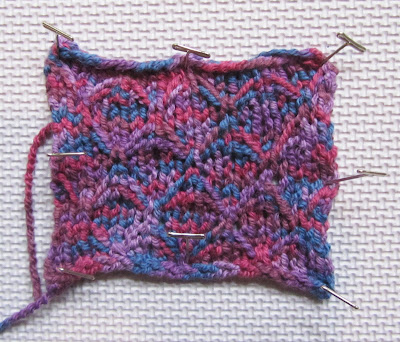This is the yarn I spun from the lavender Corriedale roving I got last October (just about a full year ago!) in Cornwall, NY. I love the various shades of purple that you can see in the skein (the green yarn is just the yarn I tied the skein up with). This was my first time spinning a singles yarn & since I knew I was over spinning it, I did some research on how to finish the yarn to avoid bias. Most of the advice I found suggested soaking it in hot water for about 30 mins, smacking it against the edge of the tub or sink to release the twist (not sure if that worked but it was fun!), then weighing it down while hanging it to dry. So I did all of those things & the yarn still had a bit of twist to it so I twisted the skein against the yarn's natural twist & that seems to have done the trick. You can still see a little bit of twist in the skein & even more in the photos I took when the yarn was hanging up to dry. This doesn't bother me too much as I've seen it in indie handspun yarns here & there.
 In other purple project news, the Vite Cowl is just flying along despite my reduced knitting abilities. Huge needles & super-bulky yarn can make even the slowest of us feel accomplished! Plus knitting on large needles doesn't bother my wrist as much as small needles do. I think I'm already well over halfway done. It's going to be super-warm & comfy & I just love the ginormous leaves! Unfortunately I'm not really sure when I'll finish this as I'm back on the knitting sidelines for the moment. I'm taking a week-long break to rest my wrist. This one is self-imposed, rather than doctor-imposed, though I'm going back to the physical therapist tomorrow for her opinion. Each time I take a break like this, I find myself aimlessly roaming the house in my free time, not sure how to occupy myself. I think that probably means that I have a co-dependent relationship with my knitting. Maybe I should just be going to a therapist!
In other purple project news, the Vite Cowl is just flying along despite my reduced knitting abilities. Huge needles & super-bulky yarn can make even the slowest of us feel accomplished! Plus knitting on large needles doesn't bother my wrist as much as small needles do. I think I'm already well over halfway done. It's going to be super-warm & comfy & I just love the ginormous leaves! Unfortunately I'm not really sure when I'll finish this as I'm back on the knitting sidelines for the moment. I'm taking a week-long break to rest my wrist. This one is self-imposed, rather than doctor-imposed, though I'm going back to the physical therapist tomorrow for her opinion. Each time I take a break like this, I find myself aimlessly roaming the house in my free time, not sure how to occupy myself. I think that probably means that I have a co-dependent relationship with my knitting. Maybe I should just be going to a therapist!
This yarn also has a bit of a halo, which I don't know how to explain or avoid in the future. I'm not sure if it's the fiber itself that creates this or something about how I'm drafting or spinning it.
 In other purple project news, the Vite Cowl is just flying along despite my reduced knitting abilities. Huge needles & super-bulky yarn can make even the slowest of us feel accomplished! Plus knitting on large needles doesn't bother my wrist as much as small needles do. I think I'm already well over halfway done. It's going to be super-warm & comfy & I just love the ginormous leaves! Unfortunately I'm not really sure when I'll finish this as I'm back on the knitting sidelines for the moment. I'm taking a week-long break to rest my wrist. This one is self-imposed, rather than doctor-imposed, though I'm going back to the physical therapist tomorrow for her opinion. Each time I take a break like this, I find myself aimlessly roaming the house in my free time, not sure how to occupy myself. I think that probably means that I have a co-dependent relationship with my knitting. Maybe I should just be going to a therapist!
In other purple project news, the Vite Cowl is just flying along despite my reduced knitting abilities. Huge needles & super-bulky yarn can make even the slowest of us feel accomplished! Plus knitting on large needles doesn't bother my wrist as much as small needles do. I think I'm already well over halfway done. It's going to be super-warm & comfy & I just love the ginormous leaves! Unfortunately I'm not really sure when I'll finish this as I'm back on the knitting sidelines for the moment. I'm taking a week-long break to rest my wrist. This one is self-imposed, rather than doctor-imposed, though I'm going back to the physical therapist tomorrow for her opinion. Each time I take a break like this, I find myself aimlessly roaming the house in my free time, not sure how to occupy myself. I think that probably means that I have a co-dependent relationship with my knitting. Maybe I should just be going to a therapist! 













































